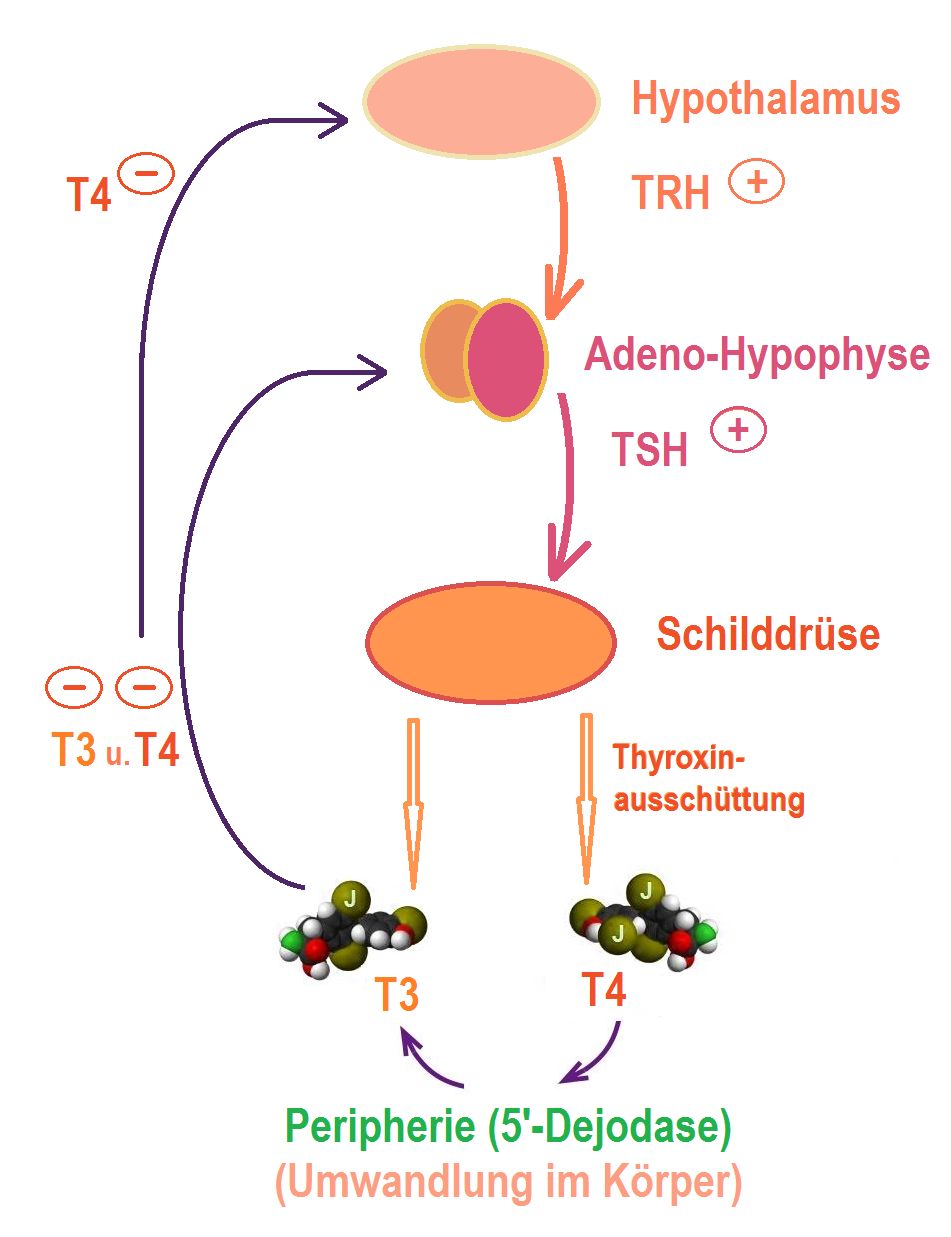Caroline Frädrich and Prof. Dr. Josef Köhrle from Charité Berlin1 together with their research partner Dr. Kostja Renko from the German Federal Institute for Risk Assessment (BfR) are honored for developing a high-throughput platform to detect hormone-active substances2. With the new platform, the research team examined 22,000 known and unknown substances, namely drugs, pharmacologically active compounds, environmental chemicals, and molecular structure fragments, for their influence on thyroid hormones. For this purpose, they made use of a method from redox chemistry for photometric iodine determination and developed the Diodinase II high-throughput assay (DIO2-HTS assay).
Three enzymes, called deiodinases 1-3 (DIO1-3), are essential components of thyroid hormone metabolism3. They can activate or inactivate thyroid hormones by removing iodine atoms from thyroid hormones at different sites. For example, deiodinases 1 and 2 convert the low-activity thyroxine (with four iodine atoms, T4) into active triiodothyronine (with three iodine atoms, T3)4 by removing an iodine ion. The thyroid hormones reach their specific receptors in the cells via the blood and influence the metabolic activity there. 
Left: less active thyroxine (T4), right: active triiodothyronine (T3).
Thyroid hormones are also important for the growth and maturation of unborn children in the womb. Until the second trimester, the fetus is dependent on the mother's thyroid hormone supply5, so that a disturbance of the thyroid function on the mother's side by e.g. environmental factors (so-called endocrine disruptors) can cause great damage to the unborn child. This can manifest itself, for example, in delays in growth and development6. Therefore, the team of scientists has found the activity of deiodinases to be an important target of investigation for screening compounds for disorders of the thyroid hormone system.
The researchers have developed the DIO2 assay based on the Sandell-Kolthoff reaction. The assay does not require conventional radioactive additives. It can be used to determine substances that inhibit or promote deiodinase activity (in this case DIO2) and thus disturb the important balance of the sensitive thyroid hormone mechanism3.
In the assay, yellow-colored cerium4+ ions are reduced to uncolored cerium3+ ions in a prepared reaction mixture using arsenic3+ ions. Iodide is previously released using recombinant human deiodinase 2 (DIO2) with the addition of thyroxine (T4) and the substances to be tested.3 The reaction rate is increased as a function of the iodide concentration present. The amount can thus be determined using a photometer.7
The Sandell-Kolthoff reaction itself is a well-known procedure and is still the basis of a WHO method for indirect iodine determination.7 The research team adapted the assay to use the 384-well high-throughput screening (HTS) plate format.
Six OECD test guidelines addressing animal studies with rats, mice, or rabbits had so far integrated the endpoint of thyroid hormone-active substances so far. These are Test Guideline 414 (Prenatal Developmental Toxicity Study), 421 (Reproductive/Developmental Toxicity Screening Test), 422 (Combined Long-Term Toxicity Study in Combination with a Reproductive/Developmental Toxicity Screening Test), 440 (Uterotrophic Bioassay in Rodents), 441 (Hershberger Assay), and 443 (Extended One-Generation Reproduction Study).8
In animal studies, either only weight and pathological changes of the thyroid are detected or only thyroid hormones (T3, T4 and TSH) are determined.8 Human-specific, significant in vitro tests are lacking.9 The development of an in vitro testing strategy, e.g. based on the exact physiological processes, is urgently needed. Therefore, the European Commission has launched the ATHENA project consortium (Assays for the identification of Thyroid Hormone axis-disrupting chemicals: Elaborating Novel Assessment strategies),10, 11 which aims to fill critical gaps in testing methods for chemicals that disrupt the thyroid hormone axis by developing new methods. It also aims to establish new endpoints for determining downstream effects on the developing brain in fetal and postnatal life5.

Thyroid hormone axis.
Graphics: Geo-Science-International, CC BY-SA 4.0, https://commons.wikimedia.org/w/index.php?curid=47357720
The research project is funded by the EU funding consortium ATHENA10, 11. Here, new methods are being developed that can detect the consequences of maternal thyroid hormone deficiency on the developing brain.
The Animal Protection Research Prize is awarded every two years by the State Office for Health and Social Affairs and the German Association of Research-Based Pharmaceutical Companies (vfa). The prize money amounts to 30,000 euros. It will be awarded on December 9 between 10 and 11 am2. Due to the current corona situation, the award ceremony and subsequent lecture can only be followed via YouTube: https://www.youtube.com/watch?v=XkLSiDlhtLA
Further information:
1 https://expendo.charite.de/en/?lang=en&option=com_user&view=reset&cHash=554a2697555a8f83cccf0e5e81febee9
2 https://www.berlin.de/lageso/gesundheit/veterinaerwesen/tierschutz/alternativmethoden/#einladung
3 Caroline Frädrich, Kostja Renko, Niklas Wiese, Anja Fischbach, Carola Seyffarth, Martin Neuenschwander, Jens Peter von Kries & Josef Köhrle (2021). A semi-automatic, non-radioactive 384-well high throughput screening DIO2 assay. Endocrine Abstracts (2021) 73 PEP10.1 | DOI: 10.1530/endoabs.73.PEP10.1
4 https://www.ncbi.nlm.nih.gov/books/NBK279388/
5 https://www.niddk.nih.gov/health-information/endocrine-diseases/pregnancy-thyroid-disease
6 https://www.ncbi.nlm.nih.gov/books/NBK279032/
7 https://link.springer.com/chapter/10.1007/978-3-662-48986-4_2732
8 https://www.oecd-ilibrary.org/environment/oecd-guidelines-for-the-testing-of-chemicals-section-4-health-effects_20745788
9 Kortenkamp, A., Marta Axelstad, M., Baig, A. H. et al. (2020). Removing Critical Gaps in Chemical Test Methods by Developing New Assays for the Identification of Thyroid Hormone System-Disrupting Chemicals-The ATHENA Project. Int. J. Mol. Sci. 2020, 21, 3123; doi:10.3390/ijms21093123
10 https://cordis.europa.eu/programme/id/H2020_SC1-BHC-27-2018
11 https://cordis.europa.eu/project/id/825161




 Dr. rer. nat.
Dr. rer. nat. Menschen für Tierrechte - Tierversuchsgegner Rheinland-Pfalz e.V.
Menschen für Tierrechte - Tierversuchsgegner Rheinland-Pfalz e.V.